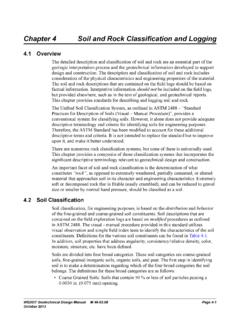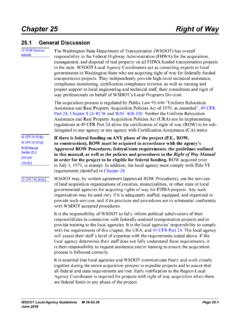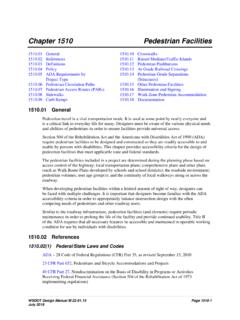Transcription of Division 9 Materials - Washington State Department of …
1 Division 9 Materials 9-00 Definitions and Tests Fracture Fractured aggregate is defined as an angular, rough, or broken surface of an aggregate particle created by crushing, or by other means. A face is considered a fractured face . whenever one-half or more of the projected area, when viewed normal to that face, is fractured with sharp and well-defined edges: this excludes small nicks. Wood Waste Wood waste is defined as all material which, after drying to constant weight, has a specific gravity of less than Test for Mass of Galvanizing At the option of the Engineer, the weight of zinc in ounce per square foot required by the various galvanizing Specifications may be determined by an approved magnetic thickness gage suitably checked and demonstrated for accuracy, in lieu of the other methods specified. Sieves for Testing Purposes Test sieves shall be made of either: (1) woven wire cloth conforming to AASHTO. Designation M 92 or ASTM Designation E 11, or (2) square-hole, perforated plates conforming to ASTM Designation E 323.
2 Dust Ratio The dust ratio is defined as the percent of material passing the No. 200 sieve divided by the percent of material passing the No. 40 sieve. Sand/Silt Ratio The sand/silt ratio is defined as the percent of material passing the No. 10 sieve divided by the percent of material passing the No. 200 sieve. Galvanized Hardware, AASHTO M232. An acceptable alternate to hot-dip galvanizing in accordance with AASHTO M 232 will be zinc coatings mechanically deposited in accordance with AASHTO M 298, providing the minimum thickness of zinc coating is not less than that specified in AASHTO M232, and the process will not produce hydrogen embrittlement in the base metal. Sampling and testing will be made by the Engineer in accordance with commonly recognized national standards and methods used in the laboratory of the Department of Transportation. Sand Equivalent The sand equivalent will be the average of duplicate determinations from a single sample. The sand equivalent sample will be prepared in accordance with the FOP for AASHTO T 176.
3 For acceptance, there must be a clear line of demarcation. If no clear line of demarcation has formed at the end of a 30-minute sedimentation period, the material will be considered as failing to meet the minimum specified sand equivalent. Field Test Procedures Field test procedures may be either a Standard Operating Procedure (SOP) or a Field Operating Procedure (FOP) for an AASHTO, ASTM, or WAQTC test procedure. A Field Operating Procedure is a technically equivalent abridged version of an AASHTO, ASTM, or WAQTC test procedure for use in field conditions. References to manuals containing all of these tests and procedures can be found in Section (1). 2018 Standard Specifications M 41-10 Page 9-1. 9-01 Cement 9-01 Cement Types of Cement Cement shall be classified as portland cement, blended hydraulic cement, or rapid hardening hydraulic cement. Specifications (1) Portland Cement Portland cement shall meet the requirements of AASHTO M85 or ASTM C150 Types I, II, or III portland cement, except that the cement shall not contain more than percent alkalies by weight calculated as Na20 plus K20 and the content of Tricalcium aluminate (C3A).
4 Shall not exceed 8 percent by weight. The time of setting shall be determined by the Vicat Test method in accordance with AASHTO T 131 or ASTM C191. (1)A Low Alkali Cement When low alkali portland cement is required, the percentage of alkalies in the cement shall not exceed percent by weight calculated as Na20 plus K20. This limitation shall apply to all types of portland cement. (1)B Blended Hydraulic Cement Blended hydraulic cement shall be either Type IP(X)(MS), Type IS(X)(MS), Type IT(PX)(LY), Type IT(SX)(LY), or Type IL(X) cement conforming to AASHTO M240 or ASTM C595, except that the portland cement used to produce blended hydraulic cement shall not contain more than percent alkalies by weight calculated as Na20 plus K20 and shall meet the following additional requirements: 1. Type IP(X)(MS) Portland-Pozzolan Cement where (X) equals the targeted percentage of fly ash, the fly ash is limited to a maximum of 35 percent by weight of the cementitious material ; (MS) indicates moderate sulfate resistance.
5 2. Type IS(X)(MS) Portland Blast- Furnace Slag Cement, where: (X) equals the targeted percentage of ground granulated blast-furnace slag, the ground granulated blast furnace slag is limited to a maximum of 50 percent by weight of the cementitious material ; (MS) indicates moderate sulfate resistance. 3. Type IT(PX)(LY), where (PX) equals the targeted percentage of pozzolan, and (LY). equals the targeted percentage of limestone. The pozzolan (PX) shall be Class F fly ash and shall be a maximum of 35 percent. (LY) shall be a minimum of 5 percent and a maximum of 15 percent. Separate testing of each source of fly ash each at each proposed replacement level shall be conducted in accordance with ASTM C1012. Expansion at 180 days shall be percent or less. 4. Type IT(SX)(LY), where (SX) equals the targeted percentage of slag cement, and (LY). equals the targeted percentage of limestone. (SX) shall be a maximum of 50 percent. (LY) shall be a minimum of 5 percent and a maximum of 15 percent.
6 Separate testing of each source of slag at each proposed replacement level shall be conducted in accordance with ASTM C1012. Expansion at 180 days shall be percent or less. 5. Type IL(X), where (X) equals the targeted percentage of limestone, and shall be a minimum of 5 percent and a maximum of 15 percent. Testing shall be conducted in accordance with ASTM C1012. Expansion at 180 days shall be percent or less. The source and weight of the fly ash or ground granulated blast furnace slag shall be certified on the cement mill test report or cement certificate of analysis and shall be reported as a percent by weight of the total cementitious material . The fly ash or ground granulated blast furnace slag constituent content in the finished cement will not vary more than plus or minus 5 percent by weight of the finished cement from the certified value. Fly ash shall meet the requirements of Section of these Standard Specifications. Page 9-2 2018 Standard Specifications M 41-10.
7 Cement 9-01. Ground granulated blast furnace slag shall meet the requirements of Section of these Standard Specifications. Limestone shall meet the requirements of AASHTO M240 or ASTM C595. (2) Rapid Hardening Hydraulic Cement Rapid hardening hydraulic cement shall meet the requirements of ASTM C 1600. Tests and Acceptance Cement may be accepted by the Engineer based on the cement mill test report number or cement certificate of analysis number indicating full conformance to the Specifications. All shipments of the cement to the Contractor or concrete supplier shall identify the applicable cement mill test report number or cement certificate of analysis number and shall be provided by the Contractor or concrete supplier with all concrete deliveries. Cement producers/suppliers that certify portland cement or blended hydraulic cement shall participate in the Cement Acceptance Program as described in WSDOT Standard Practice QC 1. Rapid hardening hydraulic cement producers/suppliers are not required to participate in WSDOT Standard Practice QC 1.
8 Each mixing facility or plant utilizing portland cement shall be equipped with a suitable means or device for obtaining a representative sample of the cement. The device shall enable the sample to be readily taken in proximity to the cement weigh hopper and from a container or conveyor holding only cement. Cement may be tested using samples taken at the job site by the Engineer for submission to the State Materials Laboratory for testing. Storage on the Work Site At the request of the Engineer, the Contractor shall provide test data to show that cement stored on site for longer than 60 days meets the requirements of Section 9-01. Tests shall be conducted on samples taken from the site in the presence of the Engineer. Test results that meet the requirements of Section 9-01 shall be valid for 60 days from the date of sampling, after which the Engineer may require further testing. 2018 Standard Specifications M 41-10 Page 9-3. 9-02 Bituminous Materials 9-02 Bituminous Materials Asphalt material , General Asphalt furnished under these Specifications shall not have been distilled at a temperature high enough to produce flecks of carbonaceous matter, and upon arrival at the Work, shall show no signs of separation into lighter and heavier components.
9 The Asphalt Supplier of Performance Graded Asphalt Binder (PGAB) and Emulsified Asphalt shall have a Quality Control Plan (QCP) in accordance with WSDOT QC 2 Standard Practice for Asphalt Suppliers That Certify Performance Graded and Emulsified Asphalts . The Asphalt Supplier's QCP shall be submitted and approved by the WSDOT State Materials Laboratory. Any change to the QCP will require a new QCP to be submitted. The Asphalt Supplier of PGAB and Emulsified Asphalt shall certify through the Bill of Lading that the PGAB or Emulsified Asphalt meets the Specification requirements of the Contract. (1) Vacant (2) Vacant (3) Vacant (4) Performance Graded Asphalt Binder (PGAB). PGAB meeting the requirements of AASHTO M320 Table 1 of the grades specified in the Contract shall be used in the production of HMA. For HMA with greater than 20 percent RAP by total weight of HMA or any amount of RAS the new asphalt binder, recycling agent and recovered asphalt (RAP and/or RAS) when blended in the proportions of the mix design shall meet the PGAB requirements of AASHTO M320 Table 1 for the grade of asphalt binder specified by the Contract.
10 In addition to AASHTO M320 Table 1 specification requirements, all performance grade (PG) asphalt binders shall meet the following requirements: Additional Requirements by Performance Grade (PG) Asphalt Binders Property Test Method PG 58-22 PG 64-22 PG 64-28 PG 70-22 PG 70-28 PG 76-28. RTFO Residue: AASHTO T 3012 60% Min. 60% Min. 60% Min. 60% Min. Elastic Recovery1. 1 Elastic Recovery @ 25 C C. 2 Specimen conditioned in accordance with AASHTO T 240 RTFO. Page 9-4 2018 Standard Specifications M 41-10. Bituminous Materials 9-02. The Direct Tension Test (AASHTO T 314) of M 320 is not a Specification requirement. The recycling agent used to rejuvenate the recovered asphalt from recycled asphalt pavement (RAP) and reclaimed asphalt shingles (RAS) shall meet the specifications in Table 1: Table 1. RA 1 RA 2 RA 25. ASTM Test Test Method Min. Max. Min. Max. Min. Max. Viscosity @ 140 F cSt D2170 or D2171 50 150 200 800 1000 4000. Flashpoint COC, F D92 400 400 400.










